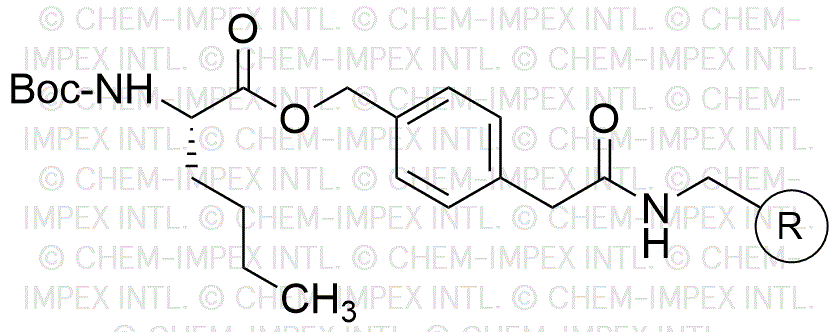Boc-L-norleucine 4-oxymethylphenylacetamidomethyl resin is widely utilized in research focused on:
- Peptide Synthesis: This resin serves as a solid support for the synthesis of peptides, allowing for efficient coupling reactions and easy purification of the final products.
- Drug Development: It plays a crucial role in the development of peptide-based therapeutics, particularly in creating compounds with enhanced bioactivity and specificity.
- Bioconjugation: The resin can be used to attach biomolecules, such as antibodies or enzymes, to peptides, improving their functionality in drug delivery systems.
- Research in Cancer Therapy: It is applied in studies aimed at developing targeted therapies for cancer, where peptide ligands are crucial for selective binding to cancer cells.
- Analytical Chemistry: The compound is also used in the preparation of standards and controls in analytical methods, ensuring accurate and reliable results in research laboratories.
General Information
Properties
Safety and Regulations
Applications
Boc-L-norleucine 4-oxymethylphenylacetamidomethyl resin is widely utilized in research focused on:
- Peptide Synthesis: This resin serves as a solid support for the synthesis of peptides, allowing for efficient coupling reactions and easy purification of the final products.
- Drug Development: It plays a crucial role in the development of peptide-based therapeutics, particularly in creating compounds with enhanced bioactivity and specificity.
- Bioconjugation: The resin can be used to attach biomolecules, such as antibodies or enzymes, to peptides, improving their functionality in drug delivery systems.
- Research in Cancer Therapy: It is applied in studies aimed at developing targeted therapies for cancer, where peptide ligands are crucial for selective binding to cancer cells.
- Analytical Chemistry: The compound is also used in the preparation of standards and controls in analytical methods, ensuring accurate and reliable results in research laboratories.
Documents
Safety Data Sheets (SDS)
The SDS provides comprehensive safety information on handling, storage, and disposal of the product.
Product Specification (PS)
The PS provides a comprehensive breakdown of the product’s properties, including chemical composition, physical state, purity, and storage requirements. It also details acceptable quality ranges and the product's intended applications.
Certificates of Analysis (COA)
Search for Certificates of Analysis (COA) by entering the products Lot Number. Lot and Batch Numbers can be found on a product’s label following the words ‘Lot’ or ‘Batch’.
*Catalog Number
*Lot Number
Certificates Of Origin (COO)
This COO confirms the country where the product was manufactured, and also details the materials and components used in it and whether it is derived from natural, synthetic, or other specific sources. This certificate may be required for customs, trade, and regulatory compliance.
*Catalog Number
*Lot Number
Safety Data Sheets (SDS)
The SDS provides comprehensive safety information on handling, storage, and disposal of the product.
DownloadProduct Specification (PS)
The PS provides a comprehensive breakdown of the product’s properties, including chemical composition, physical state, purity, and storage requirements. It also details acceptable quality ranges and the product's intended applications.
DownloadCertificates of Analysis (COA)
Search for Certificates of Analysis (COA) by entering the products Lot Number. Lot and Batch Numbers can be found on a product’s label following the words ‘Lot’ or ‘Batch’.
*Catalog Number
*Lot Number
Certificates Of Origin (COO)
This COO confirms the country where the product was manufactured, and also details the materials and components used in it and whether it is derived from natural, synthetic, or other specific sources. This certificate may be required for customs, trade, and regulatory compliance.

